Buckingham Palace
 From Nwe
From Nwe 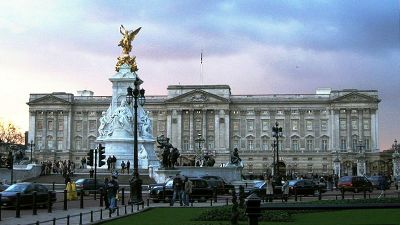
Buckingham Palace is the official London residence of the British monarch. The Palace is a setting for state occasions, royal entertaining, and is a major tourist attraction. It has been a rallying point for the British people at times of national rejoicing and crisis.
The State Rooms form the nucleus of the working Palace and are currently used regularly by King Charles III and members of the royal family for official and state entertaining. The Buckingham Palace Gardens are the largest private gardens in London.
Buckingham Palace is one of the world's most familiar buildings and more than 50,000 people visit the palace each year as guests to banquets, lunches, dinners, receptions, and the royal garden parties.
An imposing symbol of the tradition of British royalty, it also represents the might of the British Empire in its heyday, stimulating mixed emotions among contemporary commoners and the Royal Family alike.
History
The site
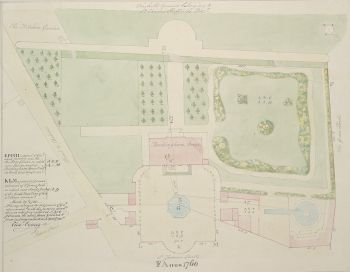
In the Middle Ages, the Buckingham Palace site formed part of the Manor of Ebury (also called Eia). The marshy ground was watered by the river Tyburn, which still flows below the courtyard and south wing of the palace. Ownership of the site changed hands many times; owners included Edward the Confessor and his queen consort Edith of Wessex in late Saxon times, and, after the Norman Conquest, William the Conqueror. William gave the site to Geoffrey de Mandeville, who bequeathed it to the monks of Westminster Abbey.
In 1531 Henry VIII acquired the Hospital of St. James (later St. James's Palace) from Eton College, and in 1536 he received the Manor of Ebury from Westminster Abbey. These transfers brought the site of Buckingham Palace back into royal hands for the first time since William the Conqueror had given it away almost 500 years earlier.
Various owners leased it from royal landlords and the freehold was the subject of frenzied speculation in the seventeenth century. Needing money, James I sold off part of the Crown freehold, but retained part of the site on which he established a four-acre mulberry garden for the production of silk. (This is at the northwest corner of today's palace.) Eventually, in the late-seventeenth century, the freehold was inherited from the property tycoon Sir Hugh Audley by the great heiress Mary Davies.
The palace building
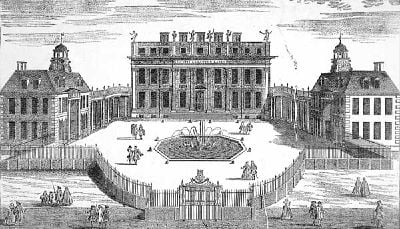
Originally known as Buckingham House, the building forming the core of today's palace was a large townhouse built for the Duke of Buckingham in 1703. The building was acquired by King George III in 1762 as a private residence, known as "The Queen's House." It was enlarged over the next 75 years, principally by architects John Nash and Edward Blore, forming three wings around a central courtyard.
Buckingham Palace finally became the official royal palace of the British monarch on the accession of Queen Victoria in 1837. The last major structural additions were made in the late nineteenth and early twentieth century, including the present-day public face of the Palace.
The Garden, the Royal Mews, and the Mall
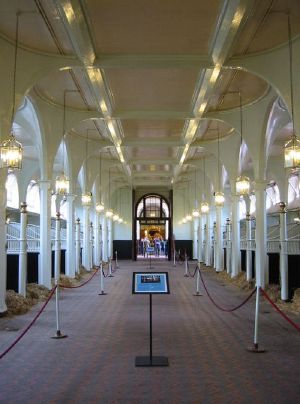
At the back of the Palace is Buckingham Palace Garden. The Garden Front of the Palace, by Nash, is made of pale golden Bath stone. The garden, which includes a lake, is the largest private garden in London. Here Queen Elizabeth II hosted her annual garden parties each summer, and, since June 2002, invited the public into the Garden on numerous occasions.
Adjacent to the Palace is the Royal Mews, also designed by Nash, where the royal carriages, including the Gold State Coach, are housed. This rococo gilt coach, designed by Sir William Chambers in 1760, has painted panels by G. B. Cipriani. It was first used for the State Opening of Parliament by George III in 1762 and is used by the monarch only for coronations or jubilee celebrations. Also housed in the Mews are the carriage horses used in royal ceremonial processions.
The Mall, a ceremonial approach route to the Palace, was designed by Sir Aston Webb and completed in 1911 as part of a grand memorial to Queen Victoria. It extends from Admiralty Arch, up around the Victoria Memorial to the Palace forecourt. This route is used by the cavalcades and motorcades of all visiting heads of state, and by the Royal Family on state occasions such as the annual State Opening of Parliament as well as Trooping the Color each year.
Home of the monarch
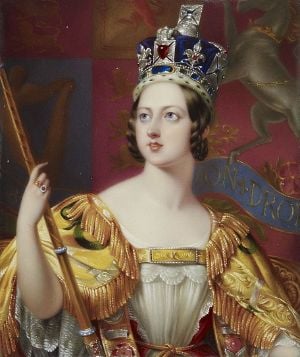
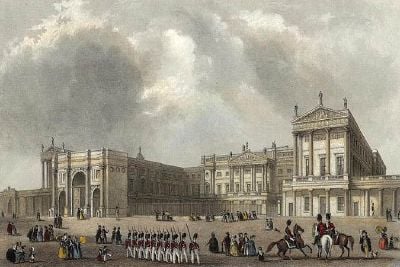
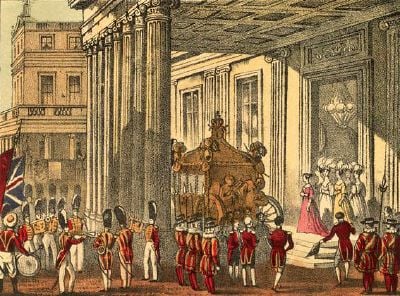
The necessities of the new palace turned out to be far from ideal royal standards. The chimneys smoked badly, and consequently the court was forced to shiver in icy magnificence. Ventilation was also poor, and the interior smelled. The installation of gas lamps led to serious worry about the build-up of gas on the lower floors. Following the Queen's marriage in 1840, her husband, Prince Albert, concerned himself with a reorganization of the household offices and staff, and dealing with the design faults of the palace; and the problems were finally rectified.
By 1847, the couple had found the palace too small for Court life and their growing family. Consequently the new wing, designed by Edward Blore, was built, enclosing the central quadrangle. This large east wing, facing The Mall is today the public face of Buckingham Palace and contains the balcony from which the Royal Family acknowledges the crowds on momentous occasions. The ballroom wing and a further suite of state rooms were also built in this period, designed by Nash's student Sir James Pennethorne.
Before Prince Albert's death, Queen Victoria was known to openly love music and dancing and the greatest contemporary musicians entertained at Buckingham Palace. Felix Mendelssohn is known to have played there on three occasions. Johann Strauss II and his orchestra also played there when in England. Strauss's "Alice Polka" was first performed at the palace in 1849 in honor of the Queen's daughter, Princess Alice. Under Victoria, Buckingham Palace was frequently the scene of lavish costume balls, in addition to the routine royal ceremonies, investitures, and presentations.
When widowed in 1861, the grief-stricken Queen withdrew from public life and left Buckingham Palace to live at Windsor Castle, and other estates. For many years the palace was seldom used. Eventually public opinion forced the Queen to return to London, though even then she preferred to live elsewhere whenever possible. Court functions were still held at Windsor Castle rather than at the palace, presided over by the sombre Queen habitually dressed in mourning black, while Buckingham palace remained shuttered for most of the year.
In the twentieth and early twenty-first century, the palace was not only the weekday home of the monarch and their children, but also the London residence of other members of the royal family. The palace also houses their offices, and is the workplace of more than 400 people.
From March 2022 till her death, Elizabeth II no longer took up residence at Buckingham Palace, preferring instead to live and conduct business at Windsor Castle.[1] She made her final appearance at the Palace on the Balcony at the conclusion of her Platinum Jubilee on June 5, 2022. She died three months later on September 8, 2022 at Balmoral Castle, after which large crowds assembled outside of the palace. Elizabeth's body lay in repose for one evening from 13 to 14 September in the Bow Room of the palace before being taken to Westminster Hall to lie in state. Her funeral procession passed the palace before the body was taken to Windsor.[2]
Charles III acceded to throne upon his mother's death, on September 8, 2022. On September 9, he made his first public appearance as King outside the Palace and addressed the nation, the commonwealth and the world from the palace. Charles was not expected to take up residence at Buckingham Palace, at least until 2023, but rather continued to reside at Clarence House, where he lived since the death of his grandmother in 2002. However, he conducted all official business at Buckingham Palace, including weekly meetings with the Prime Minister.
Interior
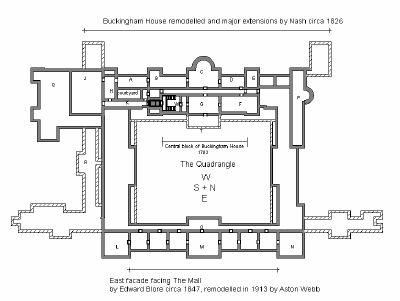
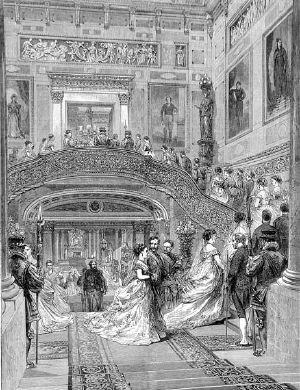
The palace contains 828,818 square feet of floor space. The principal rooms of the palace are contained on the piano nobile behind the west-facing garden facade at the rear of the building. The center of this ornate suite of State Rooms is the Music Room, its large bow the dominant feature of the facade. Flanking the Music Room are the Blue and the White Drawing rooms. At the center of the suite, serving as a corridor to link the state rooms, is the Picture Gallery, which is top lit and 55 yards long. The Gallery is hung with works by Rembrandt, van Dyck, Rubens, and Vermeer.
Other rooms leading from the Picture Gallery are the Throne Room and the Green Drawing Room. The Green Drawing room serves as a huge anteroom to the Throne Room, and is part of the ceremonial route to the Throne from the Guard Room at the top of the Grand Staircase. The Guard Room contains a white-marble statue of Prince Albert, in Roman costume set in a tribune lined with tapestries. These very formal rooms are used only for ceremonial and official entertaining.
Directly underneath the State Apartments is a suite of slightly less grand rooms known as the semi-state apartments. Opening from the marble hall, these rooms are used for less-formal entertaining, such as luncheon parties and private audiences. Some of the rooms are named and decorated for particular visitors, such as the "1844 Room," which was decorated in that year for the State visit of Emperor Nicholas I of Russia. At the center of this suite is the Bow Room, through which thousands of guests pass annually to the Garden Parties in the Gardens beyond.
Between 1847 and 1850, when Blore was building the new east wing, the Brighton Pavilion was once again plundered of its fittings for the new wing. As a result, many of the rooms in the new wing have a distinctly oriental atmosphere. The red and blue Chinese Luncheon Room is made up from parts of the Brighton banqueting and music rooms, but has a chimney piece, also from Brighton, in design more Indian than Chinese. The Yellow Drawing Room has eighteenth-century wall paper, which was supplied in 1817 for the Brighton Saloon, and the chimney piece in this room is a European vision of what the Chinese equivalent would look like, complete with nodding mandarins in niches and fearsome winged dragons.
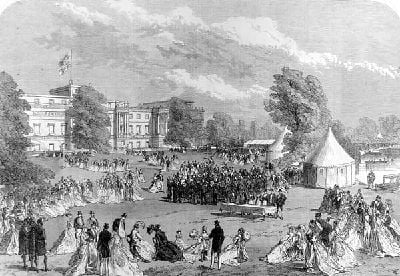
At the center of this wing is the famous balcony, with the Center Room behind its glass doors. This is a Chinese-style saloon enhanced by Queen Mary, who working with the designer Sir Charles Allom, created a more "binding" Chinese theme in the late 1920s, although the lacquer doors were brought from Brighton in 1873. Running the length of the piano nobile of the east wing is the great gallery, modestly known as the Principal Corridor, which runs the length of the eastern side of the quadrangle. It has mirrored doors, and mirrored cross walls reflecting porcelain pagodas and other oriental furniture from Brighton. The Chinese Luncheon Room and Yellow Drawing Room are situated at each end of this gallery, with the Center Room obviously placed in the center.
Visiting heads of state today, when staying at the palace, occupy a suite of rooms known as the Belgian suite, which is on the ground floor of the North-facing garden front. These rooms, with corridors enhanced by saucer domes, were first decorated for Prince Albert's uncle Léopold I, first King of the Belgians. King Edward VIII lived in these rooms during his short reign.
Court ceremonies
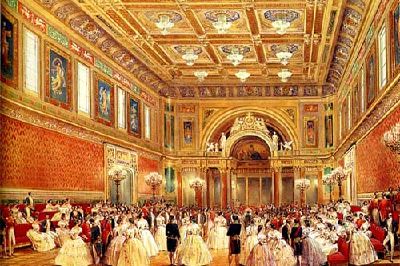
During the current reign, court ceremony has undergone a radical change, and entry to the palace is no longer the prerogative of just the upper class.
There has been a progressive relaxation of the dress code governing formal court uniform and dress. In previous reigns, men not wearing military uniform wore knee breeches of an eighteenth-century design. Women's evening dress included obligatory trains and tiaras and/or feathers in their hair. After World War I, when Queen Mary wished to follow fashion by raising her skirts a few inches from the ground, she requested a Lady-in-Waiting to shorten her own skirt first to gauge the King's reaction. King George V was horrified and Queen Mary's hemline remained unfashionably low. Subsequently, King George VI and Queen Elizabeth allowed daytime skirts to rise.
Today there is no official dress code. Most men invited to Buckingham Palace in the daytime choose to wear service uniform or morning coats, and in the evening, depending on the formality of the occasion, black tie or white tie. If the occasion is "white tie," then women, if they possess one, wear a tiara.
One of the first major changes was in 1958 when Queen Elizabeth II abolished the presentation parties for debutantes. These court presentations of aristocratic girls to the monarch took place in the Throne Room. Debutantes wore full court dress, with three tall ostrich feathers in their hair. They entered, curtsied, performed a choreographed backwards walk and a further curtsy, while maneuvering a dress train of prescribed length. The ceremony corresponded to the "court drawing rooms" of earlier reigns, and Queen Elizabeth II replaced the presentations with large and frequent palace garden parties for an invited cross-section of British society. The late Princess Margaret is reputed to have remarked of the debutante presentations: "We had to put a stop to it, every tart in London was getting in."[3] Today, the Throne Room is used for the reception of formal addresses and it is here on the throne dais that royal wedding portraits and family photographs are taken.
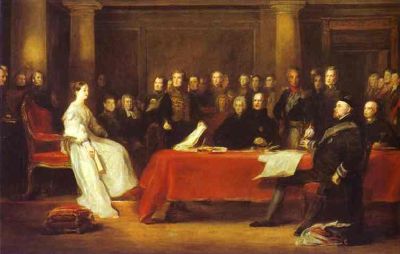
Investitures, which include the conferring of knighthoods by dubbing with a sword, and other awards take place in the palace's Victorian Ballroom, built in 1854. At 123 feet by 60 feet, this is the largest room in the palace. It has replaced the Throne Room in importance and use. During investitures the monarch stands on the throne dais beneath a giant, domed velvet canopy, known as a shamiana or a baldachin, used at the coronation of Durbar in Delhi in 1911. A military band plays in the musicians' gallery, as the recipients of awards approach the monarch and receive their honors, watched by their families and friends.
State banquets also take place in the Ballroom. These formal dinners take place on the first evening of a state visit by a visiting Head of State. On these occasions, often over 150 guests in formal "white tie and decorations," including tiaras for women, dine off gold plates. The largest and most formal reception at Buckingham Palace takes place every November, when members of the foreign diplomatic corps resident in London are entertained. Smaller ceremonies such as the reception of new ambassadors take place in the '1844 Room'. Here too small lunch parties, and often meetings of the Privy Council, are held.
The largest functions of the year are the Garden Parties for up to 8,000 invitees, taking tea and sandwiches in marquees erected in the Garden. As a military band plays the National Anthem, the monarch emerges from the Bow Room and slowly walks through the assembled guests towards his private tea tent, greeting those previously selected for the honor. Those guests who do not actually have the opportunity to meet the King at least have the consolation of being able to admire the Garden.
Modern history
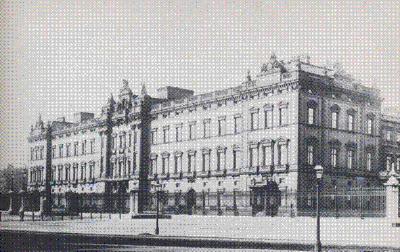
Redecoration, final building
In 1901, the accession of Edward VII saw new life breathed into the palace. The new King and his wife, Queen Alexandra, had always been at the forefront of London high society, and their friends, known as "the Marlborough House Set," were considered to be the most eminent and fashionable of the age. Buckingham Palace—the Ballroom, Grand Entrance, Marble Hall, Grand Staircase, vestibules, and galleries redecorated in the Belle epoque cream-and-gold color scheme they retain today—once again became the focal point of the British Empire and a setting for entertaining on a majestic scale. Many people feel King Edward's heavy redecoration of the palace does not complement Nash's original work. However, it has been allowed to remain for one hundred years.
The last major building work took place during the reign of King George V when, in 1913, Sir Aston Webb redesigned Blore's 1850 East Front to resemble in part Giacomo Leoni's Lyme Park in Cheshire. This new, refaced principal facade (of Portland stone) was designed to be the backdrop to the Victoria Memorial, a large memorial statue of Queen Victoria, placed outside the main gates. George V, who had succeeded Edward VII in 1910, had a more serious personality than his father; greater emphasis was now placed on official entertaining and royal duties than on lavish parties.
George V's wife, Queen Mary, was a connoisseur of the arts and took a keen interest in the Royal collection of furniture and art, both restoring and adding to it. Queen Mary also had many new fixtures and fittings installed, such as the pair of marble Empire-style chimney pieces by Benjamin Vulliamy, dating from 1810, which the Queen had installed in the ground floor Bow Room, the huge low room at the center of the garden facade. Queen Mary was also responsible for the decoration of the lavish Blue Drawing Room.
In 1999[4] that the palace contained 19 state rooms, 52 principal bedrooms, 188 staff bedrooms, 92 offices, and 78 bathrooms. While this may seem large, it is small when compared to the Tsar's palaces in St. Petersburg and at Tsarskoe Selo, the Papal Palace in Rome, the Royal Palace of Madrid, or indeed, the former Palace of Whitehall, and tiny compared to the Forbidden City and Potala Palace. The relative smallness of the palace may be best appreciated from within, looking out over the inner quadrangle. A minor extension was made in 1938, in which the northwest pavilion, designed by Nash, was converted into a swimming pool.
World War I and II
During World War I the Palace, then the home of King George V and Queen Mary, escaped unscathed. Its more valuable contents were evacuated to Windsor, but the Royal family remained in situ. The largest change to court life at this time was that the government persuaded the King to ostentatiously and publicly lock the wine cellars and refrain from alcohol for the duration of the war, to set a good example to the supposedly inebriated lower classes. The lower classes continued to imbibe and the King was left reputedly furious at his enforced abstinence.[5] The King's children were photographed at this time serving tea to wounded officers in the adjacent Royal Mews.
During World War II the Palace fared worse: it was bombed no less than seven times, and was a deliberate target, as it was thought by the Nazis that the destruction of Buckingham Palace would demoralize the nation. One bomb fell in the palace quadrangle while King George VI and Queen Elizabeth were in residence, but while many windows were blown in and the chapel destroyed, they escaped harm. However, war-time coverage of such incidents was severely restricted. The most serious and publicized bombing was the destruction of the palace chapel in 1940: coverage of this event was played in cinemas all over England to show the common suffering of rich and poor. The King and Queen were filmed inspecting their bombed home, the smiling Queen, as always, immaculately dressed in a hat and matching coat seemingly unbothered by the damage around her. It was at this time the Queen famously declared: "I'm glad we have been bombed. Now I can look the East End in the face." The Royal family were seen as sharing their subjects' hardship, as The Sunday Graphic reported:
On VE Day —May 8, 1945—the Palace was the center of British celebrations, with the King, Queen and the Princess Elizabeth, the future Queen, and Princess Margaret appearing on the balcony, with the palace's blacked-out windows behind them, to the cheers from a vast crowd in the Mall.
Palace use and public access

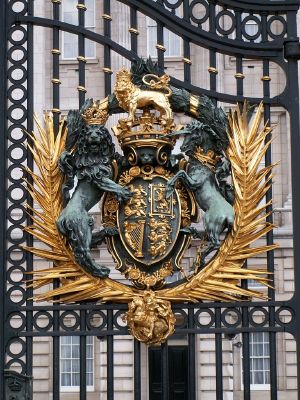
Today, Buckingham Palace is the London residence of members of the Royal Family. The palace also houses the offices of the Royal Household and is the workplace of 450 people.
Every year some 50,000 invited guests are entertained at garden parties, receptions, audiences, and banquets. The garden parties, usually three, are held in the summer, usually in July. The Forecourt of Buckingham Palace is used for Changing of the Guard, a major ceremony and tourist attraction (daily during the summer months; every other day during the winter).
The palace is not the monarch's private property; both Windsor Castle and Buckingham Palace and their art collections belong to the nation. The furnishings, paintings, fittings, and other artifacts, many by Fabergé, from Buckingham Palace and Windsor Castle are known collectively as the Royal Collection; owned by the nation, they can be viewed by the public. The Queen's Gallery near the Royal Mews is open all year and displays a changing selection of items from the collection. The rooms containing the Queen's Gallery are on the site of the former chapel, which was damaged by one of the seven bombs to fall on the Palace during World War II. The Palace's State Rooms have been open to the public during August and September since 1993. The money raised in entry fees was originally put towards the rebuilding of Windsor Castle following the 1992 fire which destroyed many of its State Rooms.
Thus, Buckingham Palace is a symbol and home of the British Monarchy, an Art Gallery, and a tourist attraction. Behind the gilded railings and gates, which were made by the Bromsgrove Guild, and Webb's famous facade which has been described as looking "'like everybody's idea of a palace," the large staff employed by the Royal Household work to keep Britain's constitutional monarchy functioning.
Notes
- ↑ Roya Nikkhah, The Queen makes permanent move to Windsor Castle The Sunday Times, March 6, 2022. Retrieved October 13, 2022.
- ↑ Chloe Best, Inside Buckingham Palace's historic Bow Room where Queen Elizabeth II will lie in state HELLO!, September 13, 2022. Retrieved October 13, 2022.
- ↑ Thomas Blaikie, You look awfully like the Queen: Wit and Wisdom from the House of Windsor (Harper Collins, 2002, ISBN 0007148747).
- ↑ John Martin Robinson, Buckingham Palace. (London: The Royal Collection, 1999, ISBN 1902163362), 11.
- ↑ Kenneth Rose, King George V. (Weidenfeld and Nicolson, 1983, ISBN 0297782452).
References
ISBN links support NWE through referral fees
- Blaikie, Thomas. You look awfully like the Queen: Wit and Wisdom from the House of Windsor. Harper Collins, 2002. ISBN 0007148747
- Harris, John, Geoffrey de Bellaigue, and Oliver Miller. Buckingham Palace. Nelson, 1968. ISBN 0171410114
- Hedley, Olwen. The Pictorial History of Buckingham Palace. Pitkin, 1971. ISBN 085372086X
- Nash, Roy. Buckingham Palace: The Place and the People. Macdonald Futura, 1980. ISBN 0354045296
- Robinson, John Martin. Buckingham Palace. London: The Royal Collection, 1999. ISBN 1902163362
- Rose, Kenneth. King George V. Weidenfeld and Nicolson, 1983. ISBN 0297782452
- Williams, Neville. Royal Homes. Lutterworth Press, 1971. ISBN 0718808037
- Wright, Patricia. The Strange History of Buckingham Palace. Sutton Publishing Ltd., 1999. ISBN 0750912839
External links
All links retrieved October 13, 2022.
- Westminster: Buckingham Palace, from Edward Walford, Old and New London, Vol 4, Chap. VI (1878).
Credits
New World Encyclopedia writers and editors rewrote and completed the Wikipedia article in accordance with New World Encyclopedia standards. This article abides by terms of the Creative Commons CC-by-sa 3.0 License (CC-by-sa), which may be used and disseminated with proper attribution. Credit is due under the terms of this license that can reference both the New World Encyclopedia contributors and the selfless volunteer contributors of the Wikimedia Foundation. To cite this article click here for a list of acceptable citing formats.The history of earlier contributions by wikipedians is accessible to researchers here:
- Buckingham Palace history
The history of this article since it was imported to New World Encyclopedia:
- History of "Buckingham Palace"
Note: Some restrictions may apply to use of individual images which are separately licensed.
↧ Download as ZWI file | Last modified: 02/03/2023 20:57:20 | 13 views
☰ Source: https://www.newworldencyclopedia.org/entry/Buckingham_Palace | License: CC BY-SA 3.0
 ZWI signed:
ZWI signed: KSF
KSF